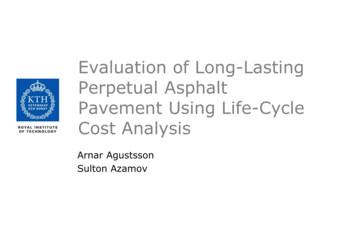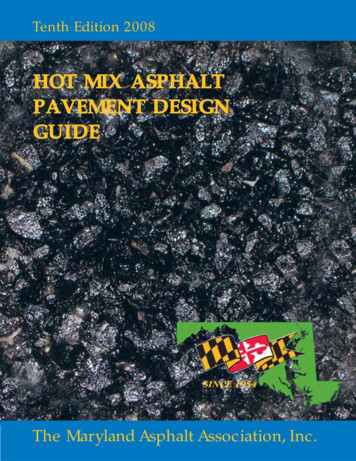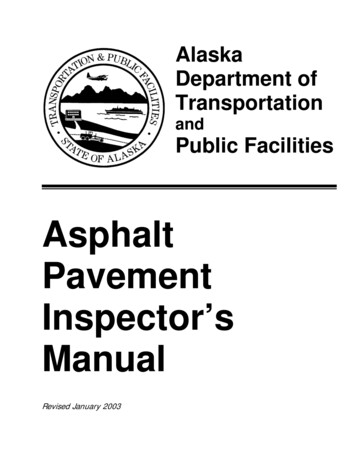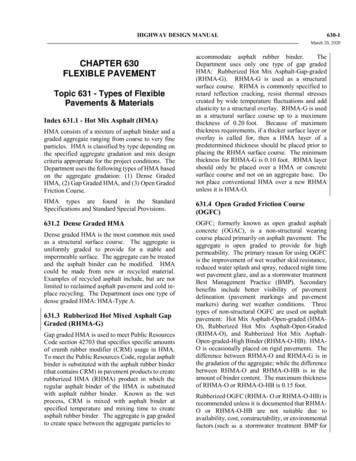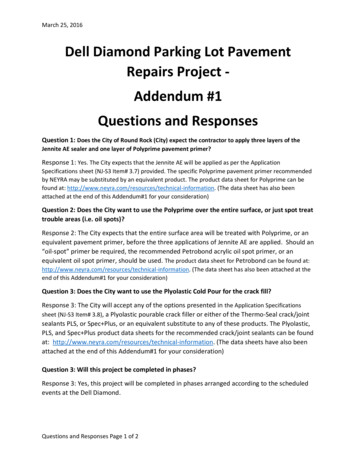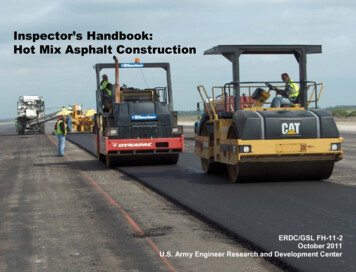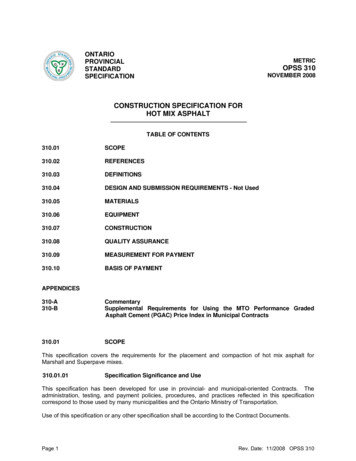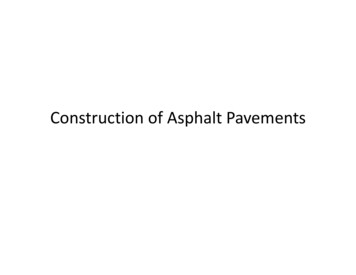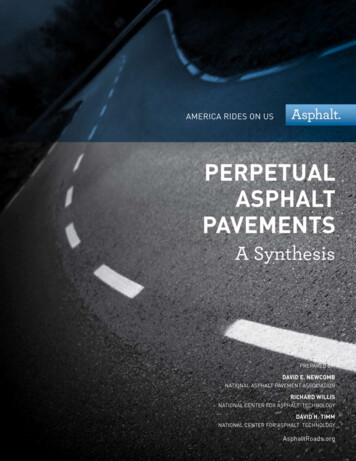
Transcription
Asphalt Pavement Alliance IM-401
PerpetualAsphaltPavementsA Synthesisn Introduction . . 3Background. 3Objectives. 5Scope. 5n Design. 6Overview . 6Limiting Pavement Responses . 11Structural Rutting . 11Fatigue Cracking . 12Perpetual Pavement Design Approaches . 13High Volume Pavements . 13Lower Volume Pavements . . 15High-modulus Pavements . 16Design for Pavement Rehabilitation . . 16Summary . 18n Materials . 19Foundation . 19Asphalt Mix Design and Materials . . 22Asphalt Base Layer . . 24Intermediate Layer . 26Wearing Surface . 27Summary . 28n Construction. 29n Performance. 32n Summary. 36n Recommendations. 38n References. 39Asphalt Pavement Alliance IM-4023/28/10
IntroductionnBackgroundThe concept of Perpetual Pavements was introduced in 2000 by the Asphalt PavementAlliance (APA). They defined a Perpetual Pavement as “an asphalt pavement designedand built to last longer than 50 years without requiring major structural rehabilitationor reconstruction, and needing only periodic surface renewal in response to distressesconfined to the top of the pavement” (APA, 2002). At that time, it was recognized thatmany well-built, thick asphalt pavements that were categorized as either full-depth ordeep-strength pavements had been in service for decades with only minor periodicsurface rehabilitation to remove defects and improve ride quality. The advantages ofsuch pavements include:1. Low life-cycle cost by avoiding deep pavement repairs or reconstruction,2. Low user-delay costs since minor surface rehabilitation of asphalt pavementsonly requires short work windows that can avoid peak traffic hours, and3. Low environmental impact by reducing the amount of material resourcesover the pavement’s life and recycling any materials removed from thepavement surface.A somewhat unified approach to designing Perpetual Pavements was adopted by anumber of experts (Thompson and Carpenter, 2004; Timm and Newcomb, 2006) basedon mechanistic-empirical concepts originally proposed by Monismith (1992) in the design of the I-710 freeway in California. The premise to this approach was that pavementdistresses with deep structural origins could be avoided if pavement responses such asstresses, strains, and deflections could be kept below thresholds where the distressesbegin to occur. Thus, an asphalt pavement could be designed for an indefinite structurallife by designing for the heaviest vehicles without being overly conservative.This contrasts to empirical methods that predated the Perpetual Pavement designapproach. In those design procedures, greater volumes of heavy vehicles resulted ingreater pavement thickness. This was due largely to the way these empirical methodswere developed. For instance, the 1993 American Association of State Highway andTransportation Officials (AASHTO) Guide for the Design of Pavement Structures wasbased on the results of a road test conducted from 1958 to 1961. In this study, pavements were subjected to 1 million axle load applications, and failures were monitoredPerpetual Pavement is “an asphalt pavement designed and builtto last longer than 50 years without requiringmajor structural rehabilitation or reconstruction,and needing only periodic surface renewalin response to distresses confined to the top of the pavement.”Asphalt Pavement Alliance IM-403
over time. The heaviest single axle load used at the AASHO Road Test (30,000 lb) appliedabout 8 million equivalent single axle loads (ESAL) (18,000 lb equivalents) to the thickest asphalt section. Since that time, pavement structures have been designed for heavytraffic volumes that exceed the 8 million ESAL level by 25 times, thus forcing pavementdesigners to extrapolate the road test results far beyond the conditions for which theywere developed. The result of this extrapolation was ever-increasing thickness with trafficvolume, instead of recognizing the pavement thickness at which the heaviest loads couldbe sustained without additional structure. Thus, the idea of Perpetual Pavements cameinto existence as much to prevent over-design as to provide a long-life structure.Since the time of the introduction of Perpetual Pavements in 2000, some of the important milestones have been:The Arkansas State Highway and Transportation Department received a 2009Perpetual Pavement Award for Highway 134-North, Miller County, US 71,Section 2.n The Asphalt Pavement Alliance has presented 69 Perpetual Pavement awardsfrom 2001 to 2009.n The International Society for Asphalt Pavements dedicated a special session toPerpetual Pavements in 2002.n Three international conferences have been held on the topic, one at AuburnUniversity in 2004 and the others at Ohio University in 2006 and 2009.n The Transportation Research Board held a workshop session on PerpetualPavements in 2001.Asphalt Pavement Alliance IM-404
n The Federation of European Highway and Road Laboratories (FEHRL) hasundertaken a series of efforts to define long-life pavements (Ferne and Nunn,2004; Ferne, 2006).n Three major national studies on Perpetual Pavements were initiated throughthe National Cooperative Highway Research Program (NCHRP).n State studies on Perpetual Pavements have been or are currently beingconducted in Kansas (Romanoschi et al., 2006), Ohio (Sargand et al., 2006),Wisconsin (Crovetti et al., 2008), Pennsylvania (Solaimanian et al., 2006),Oklahoma (Gierhart, 2008), Texas (Scullion, 2006), Michigan (Von Quintus,2001b; Von Quintus and Tam, 2001), New Mexico (TRB, 2009), Illinois(Thomson and Carpenter, 2004), Washington (Mahoney, 2001), and California(Monismith et al., 2009).n Perpetual Pavement design workshops have been held in Ohio, Kansas,Oregon, Colorado, Texas, Minnesota, Tennessee, Georgia, Hawaii, Wisconsin,Oklahoma, and Indiana.n The National Center for Asphalt Technology (NCAT) Test Track has pavementtest sections designed as Perpetual Pavements which are instrumented tovalidate the design concepts.n Two pavement design computer programs specifically for Perpetual Pavementshave been developed at Auburn University.n The concept of the endurance limit has been incorporated in the newAmerican Association of State Highway and Transportation Officials (AASHTO)Mechanistic-Empirical Pavement Design Guide (MEPDG) (AASHTO, 2008).State departments of transportation and local agencies are considering methods toincorporate the concepts of Perpetual Pavement design into their asset managementstrategies to more wisely spend their infrastructure funds.This document aims to:Objectives1. Capture the activities that have taken place over the past decade.2. Synthesize the information in a way useful to providing guidance forPerpetual Pavement design and construction.3. Provide a vision for further research and development to refinePerpetual Pavements.ScopeThis synthesis begins with a discussion of Perpetual Pavement design for both newand rehabilitation designs. This is followed by a summary of material characteristics tobe considered in design and performance. Construction practices are reviewed, followedby a discussion on the performance of long-lasting asphalt pavements.Asphalt Pavement Alliance IM-405
DesignnOverviewPavement engineers have been producing long-lasting asphalt pavements since the1960s. Research has shown that well-constructed and well-designed flexible pavementscan perform for extended periods of time (Mahoney, 2001; Harvey et al., 2004). Many ofthese pavements in the past forty years were the products of full-depth or deep-strengthasphalt pavement designs, and both have design philosophies that have been shownto provide adequate strength over extended life cycles (APA, 2002). It is significant thatthese pavements have endured an unprecedented amount of traffic growth. For instance,from 1970 to 1998, the average daily ton-miles of freight increased by 580 percent, and theaverage freight loading continues to increase 2.7 percent per year (D’Angelo et al., 2004).As the demand on existing pavements in the U.S. increases with potentially minimalfunding for expansion and rehabilitation, efficient design of new and rehabilitated sectionsThe Kentucky Transportation Cabinet received a 2009 Perpetual PavementAward for Louisville-Tennessee Road, I-65, Hart County.Asphalt Pavement Alliance IM-406
through Perpetual Pavement design will become increasingly important. Congestion onthe existing system is at a point that requires pavements that can be maintained withminimal disruption of traffic.Full-depth pavements are constructed by placing asphalt layers on modified or unmodified soil or subgrade material. Deep-strength pavements consist of asphalt layerson top of a thin granular base. Both of these design scenarios allow pavement engineersto employ a thinner total pavement section than if a thick granular base were used. Byreducing the potential for fatigue cracking and confining cracking to the upper removable/replaceable layers, many of these pavements have far exceeded their design lifeof 20 years with minimal rehabilitation; therefore, they are considered to be superiorpavements (APA, 2002).Pavements which are either under-designed or poorly constructed exhibit structuraldistresses, such as fatigue cracking and rutting (Mahoney, 2001), before their designlife is achieved. The successes seen in the full-depth and deep-strength pavementsare the results of designing and constructing pavements that resist these detrimentsto the pavement’s structure. In recent years, pavement engineers have begun to adopt.pavement engineers have begun to adopta methodology of designing pavementsto resist bottom-up fatigue crackingand deep structural rutting,the two most devastating pavement distresses,and through this change in thinkingthe idea of Perpetual Pavementsor long-lasting pavements has evolved.a methodology of designing pavements to resist bottom-up fatigue cracking and deepstructural rutting, the two most devastating pavement distresses, and through this changein thinking the idea of Perpetual Pavements or long-lasting pavements has evolved.The approach to the design of long-life or Perpetual Pavements requires a differentstrategy than that which has normally been applied to pavement design in the past. Empirical pavement design must rely on relationships between observations of pavementperformance, a scale that represents traffic, some gross indicator of material quality suchas a structural coefficient, and the thickness of the layers. For a given level of materialquality, the thickness of the pavement increases with increasing traffic. However, therecomes a point beyond which the thickness of the pavement is more than adequate for theheaviest loads expected and any additional pavement results in an overly-conservativecross section and an unnecessary added cost. In addition to being extravagant froma cost standpoint, such an overuse of resources does not fit within an environmentalsustainability framework. As a case in point, Huber et al. (2009) found that the 1993AASHTO pavement design guide (AASHTO, 1993) typically over-designed pavementsin Indiana by 1.5 to 4.5 inches which amounts to approximately 600 to 1800 tons ofmaterial per lane-mile beyond what is needed.Asphalt Pavement Alliance IM-407
A better approach to the design of Perpetual Pavements is the mechanistic-empiricalmethod.
For instance, the 1993 American Association of state highway and transportation Officials (AAshtO) Guide for the Design of pavement structures was based on the results of a road test conducted from 1958 to 1961. in this study, pave- ments were subjected to 1 million axle load applications, and failures were monitored Perpetual Pavement is “an asphalt pavement designed and built to last .
